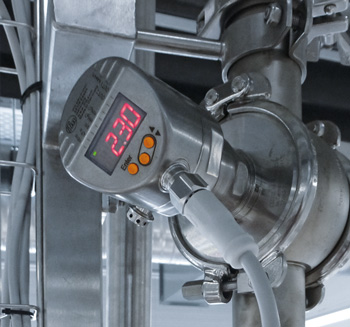 I requisiti richiesti ai sensori utilizzati nell’industria alimentare sono notevoli. Design igienico, elevato grado di protezione e robustezza sono solo alcuni di questi. I nuovi sensori di pressione della serie PI1xxx di ifm soddisfano queste necessità proprio come i modelli precedenti, offrendo molti più vantaggi
I requisiti richiesti ai sensori utilizzati nell’industria alimentare sono notevoli. Design igienico, elevato grado di protezione e robustezza sono solo alcuni di questi. I nuovi sensori di pressione della serie PI1xxx di ifm soddisfano queste necessità proprio come i modelli precedenti, offrendo molti più vantaggi
I nuovi sensori di pressione PI1xxx sono utilizzati principalmente nell’industria alimentare, ideali per la misurazione della pressione in serbatoi e tubi nella produzione alimentare, ad esempio in caseifici, birrifici e molte altre applicazioni in cui vengono utilizzati liquidi. Soddisfano quindi tutti i più comuni requisiti igienici: sono omologati secondo EHEDG e FDA, con grado di protezione IP69K, in modo che la pulizia giornaliera ad alta pressione non sia un problema. I sensori utilizzano un elemento di misura capacitivo in ceramica e sono quindi estremamente robusti. Fluidi abrasivi o corrosivi, picchi di vuoto o pressione non possono danneggiare l’elemento del sensore, che inoltre resiste in modo permanente a temperature medie di 150°C ed è quindi, anche da questo punto di vista, adatto per molte applicazioni tipiche del settore alimentare. La temperatura del liquido può essere letta anche tramite IO-Link. Inoltre, la guarnizione in PTFE, che non richiede manutenzione permanente, contribuisce ad incrementarne la robustezza.
Risoluzione superiore, design migliorato
I nuovi sensori di pressione, disponibili con diversi campi di misura dal vuoto fino a 100 bar, ora comunicano tramite IO-Link 1.1 e offrono una risoluzione a 32 bit. Ciò è particolarmente importante per le applicazioni in cui vengono misurate pressioni differenziali e quindi solo una piccola parte del campo di misura può essere utilizzata. Anche la compensazione della temperatura è stata migliorata nella nuova serie. Nel settore Agroalimentare solitamente gli impianti vengono sanificati attraverso il ciclo CIP, che prevede l’alternanza di passaggio di liquidi caldi e freddi. Per queste fasi, e per tutte quelle del processo, nelle quali ci sono repentini cambi di temperatura, è importante che il sensore possa tempestivamente fornire valori di pressione corretti. Questa funzione è stata notevolmente migliorata nel nuovo PI1xxx, in modo da aumentare significativamente l’efficienza e l’efficacia in queste applicazioni.
Anche i più piccoli miglioramenti nella progettazione di un sensore possono avere un grande impatto sulle applicazioni. Ad esempio, il foro di compensazione sul nuovo sensore di pressione è stato ruotato di 90° ed è ora posizionato lateralmente, quando montato in modo convenzionale. Questo impedisce alla condensa, ad esempio, di raccogliersi sulla membrana del foro di sfiato e causare sporcizia o comprometterne il funzionamento. Il PI1xxx è stato ottimizzato anche in termini di semplicità d’uso: il nuovo concetto operativo con tre pulsanti rende l’impostazione dei parametri molto più comoda e quindi anche più veloce.
Making good things even better
The requirements for sensors used in the food industry are high. Hygienic design, high protection rating and robustness are just some of them. The new pressure sensors of the PI1xxx series fulfil these requirements just like the predecessor models but offer many more advantages
The new PI1xxx pressure sensors are mainly used in the food industry and therefore meet all common hygienic requirements. Among other things, they are certified according to EHEDG and FDA and meet protection rating IP69K, so that daily cleaning with a high-pressure cleaner is no problem. The sensors use a capacitive ceramic measuring element and are therefore extremely robust. Neither abrasive or corrosive media nor vacuum or pressure peaks can harm the sensor element. In addition, the sensor permanently withstands 150°C media temperatures and is thus suitable for many high-temperature applications in the food industry. The media temperature can also be read via IO-Link. The PTFE seal, which is permanently maintenance-free, also contributes to the robustness.
Higher resolution, improved design
The new pressure sensors, which are available with different measuring ranges from vacuum to 100 bar, now communicate via IO-Link 1.1 and offer a resolution of about 32 bits. This is especially important for applications where differential pressures are measured and thus only a small part of the measuring range can be used. Temperature compensation has also been improved in the new series. In food industry plants, the CIP process in which the installations are cleaned with hot liquids is the standard. If production is to be resumed at low temperatures afterwards, it is important that the sensor functions reliably again as quickly as possible. This has been significantly improved in the new PI1xxx, so that production can restart much faster after cleaning – in many applications this leads to a significant increase in efficiency.
Even seemingly small improvements to the design of a sensor can have a big impact in the application. For example, the vent hole on the new pressure sensor has been offset by 90° and is now located on the side when mounted conventionally. This prevents condensate, for example, from collecting on the membrane of the vent hole and causing soiling or impairing the function. The PI1xxx has also been optimised in terms of user-friendliness: The new operating concept with three pushbuttons makes parameter setting much more convenient and thus also faster.
The pressure sensors of the new PI1xxx series are ideally suited for applications in the food industry – for example in dairies, breweries and many other applications where liquids are used. Pressure measurements in these applications are carried out in tanks as well as in pipes. The numerous improvements of the sensors offer important advantages to the user.











